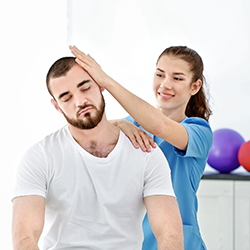Neck Exercises to Relieve Cervical Spondylosis

The American Academy of Orthopaedic Surgeons (AAOS) estimates that 65% of people over the age of 65 live with cervical spondylosis. The condition often causes pain and stiffness in the neck. In most cases, cervical spondylosis responds well to conservative treatment, particularly physical therapy. The spine is made up of 24 bones, vertebrae, stacked on top of one another. In between the vertebrae are flexible intervertebral discs, which work as shock absorbers, and facet joints, which work as stabilizers. The vertebrae bones connect to create a canal that protects the spinal cord. The seven small vertebrae that begin at the base of the skull and form the neck comprise the cervical spine. Cervical spondylosis occurs in the cervical spine. As the discs in the spine age, they lose water content and begin to dry out and weaken, causing collapsing of the disc spaces and wearing away of the cartilage that covers and protects the facet joints. Age is the most common risk factor for cervical spondylosis.
After discussing medical history and general health with your DOC orthopedic surgeon or physician assistant, he or she will conduct a thorough examination of the neck, shoulders, arms, and legs. Diagnostic tests help to confirm the diagnosis of cervical spondylosis. X-rays show the alignment of the bones along the neck and any degenerative changes. MRI scans create better images of the body’s soft tissues, muscles, discs, nerves, and the spinal cord. If a diagnosis of cervical spondylosis is confirmed, the DOC team recommends nonsurgical treatment, physical therapy, to ease the guest’s symptoms. The DOC physical therapist works with the guest to help moderate the impact of cervical spondylosis and alleviate pain or stiffness through a customized exercise program. A 2018 article in Medical News Today, What’s to know about cervical spondylosis? provides some simple neck exercises:
Neck stretches
- Keep the body straight and push the chin forward to stretch the throat, tensing the neck muscles. Hold 5 seconds. Return to a neutral position. 5 repetitions.
- Push the head back with the chin held high. Hold 5 seconds. 5 repetitions.
Neck Tilt
- Tilt the head forward so the chin touches the chest, tensing the neck muscles. Hold 5 seconds. Return to a neutral position. 5 repetitions.
Side-to-Side Neck Tilt
- Lean the head sideways toward the shoulder, tensing the neck muscles. Hold 5 seconds. Return to a neutral position. Repeat towards your other shoulder. 5 repetitions each side.
Neck Turn
- Turn the head to one side as far as the movement is comfortable, keeping the chin level, tensing neck muscles. Hold 5 seconds. Return to a neutral position. Repeat in the opposite direction. 5 repetitions each side.
Cervical spondylosis cannot be prevented, but symptoms can be controlled. Other physical therapy treatments may include posture therapy, traction to gently stretch the joints and muscles of the neck, ice, heat, massage, or a temporary soft neck brace. If conservative treatments fail to relieve pain and stiffness, discuss options with the DOC healthcare team. Guests who have progressive neurologic symptoms, such as arm weakness, numbness, falling, or persistent severe pain, maybe helped by steroid injections or surgery.
For more information on the cost of care, click here.




